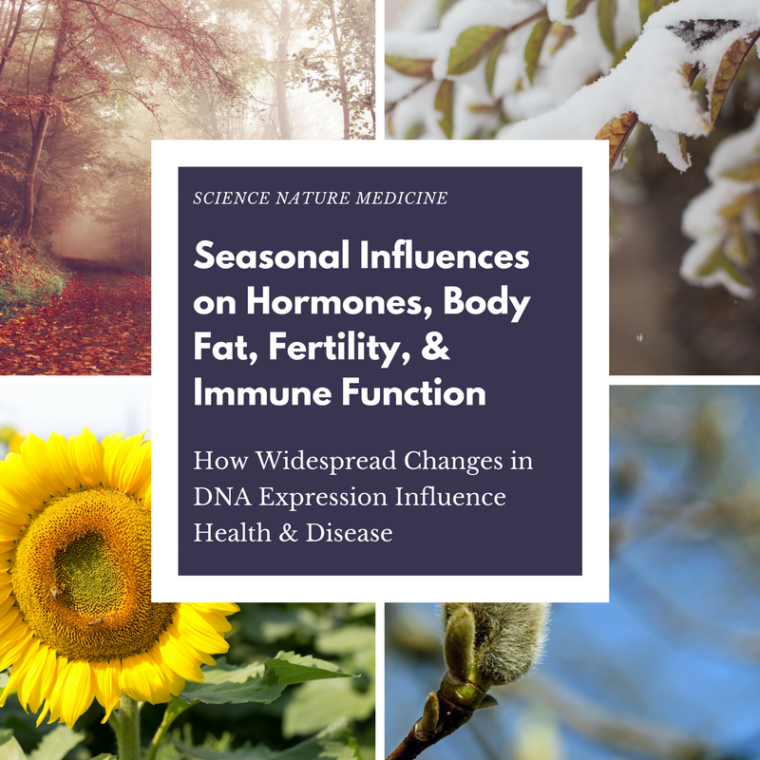Crisp, cool morning air, the trees afire in their autumnal senescence, the crunch of the first leaves under our boot soles, and the promise of warm apple cider donuts at weekend farm visits… its what many New Englanders wait all year for… we’re spoiled. Peak leaf season is right around the corner and we’ll embrace every minute.

We may be fully aware that the season is changing, with “pumpkin everything,” flannel, and apple picking, but there are far more interesting changes transpiring in our bodies that you probably don’t even realize are happening. If you feel you gain body fat in colder months and wonder if it’s just the pumpkin spice lattes adding up, or perhaps you experience a little more joint pain, or maybe in the fall you even feel a little more… frisky, it isn’t just your imagination. There are a lot of changes happening underneath the surface, particularly to your DNA.

The way your DNA is expressed can change without altering your actual DNA sequence. This happens via modifications on top of your DNA that turn genes on or off, known as epigenetics. Epigenetic modifications can be triggered by our environment. As daylight, humidity, and temperature change, our circadian rhythm is impacted, with 9 of 16 circadian clock genes fluctuating with the season. (Side note: 3 U.S. scientists just won the 2017 Nobel prize in medicine for their work on clock genes!) (1) These changes go much further beyond melatonin and our sleep-wake cycle. Body composition, immune health, autoimmunity, inflammation, hormones, and fertility all change with the seasons.
As a doctor, my patients often report improvements or exacerbations that coincide with seasonal change. Indeed, certain conditions are clinically worse or diagnosed more frequently in colder months such as heart disease and autoimmune disease. These seasonal changes may be largely due to the vast number of changes in DNA expression throughout the year. In one study, 23% of the genome changed seasonally! (2)
It is important to note that because of seasonal differences throughout the world, such as in the Northern vs. Southern hemisphere, these correlations are dependent on where you live. I focused on the Northern hemisphere, particularly with studies from the United States and Europe.
Body Composition and Hormones
Many of my patients attribute seasonal body composition changes to a switch to more fresh seasonal veggies in the spring and summer, and a more sedentary lifestyle, cozied up indoors in autumn and winter. Studies have shown there’s more to it than that. These seasonal fluctuations are also impacted by changes in DNA expression and hormone levels. These changes occur right in adipose (fat) tissue, and many of the genes are involved in metabolic pathways. (1)
Body Fat and Metabolic Factors
In one study, body fat and hemoglobin A1c, a test often used in screening for diabetes, increased during the winter and decreased in the summer. This may be attributable to an increase in insulin resistance in the winter. (3) Insulin resistance means the cells in your body aren’t as sensitive to insulin signals and blood sugar levels rise.

Adiponectin levels also vary. Adiponectin is a protein involved in blood sugar and lipid metabolism that tends to be lower in obese people and higher in lean people. Genes coding for adiponectin are more highly expressed during the summer, (1) supporting the pattern of a leaner body composition and improved blood sugar control in the summer.
Furthermore, cortisol and glucocorticoids are higher in the winter. (4) Cortisol, also known as the stress hormone, has a diurnal rhythm, rising in the morning and generally decreasing throughout the day. It is a very important and necessary hormone, but too high of levels over long periods of time have negative consequences. High cortisol is associated with weight gain, particularly in the midsection, low immune response, exacerbation of cardiovascular disease, and more. These higher winter cortisol levels may contribute to increased cardiovascular disease and central adiposity in winter months.
Learn more about the biology of fat and how inflammation affects body weight here.
Sex Hormones
Sex hormones like estrogen and testosterone have several well-known temporal rhythms. Estrogen levels in women fluctuate throughout their monthly cycle in the premenopausal period and decline beginning in menopause. Testosterone also declines with age, tends to be higher in the morning and lower in the evening.
Estrogen
Genes coding for estradiol, a form of estrogen, are more highly expressed in the summer, (1) resulting in peak estrogen for post-menopausal women in June, while men to have peak estrogen in May. (5) Estrogen has effects all throughout the body. Beyond the female reproductive system, estrogen levels have been shown to influence working memory, body temperature, cholesterol, bone density, and more. Estrogen also works in balance with other hormones like progesterone. Depending on individual hormonal balance, particularly women, these seasonal fluctuations could influence symptoms like those associated with menstrual cycles, as well as blood work like cholesterol levels. Many people attribute lower summer cholesterol levels to a change in eating habits, however these numbers may also be affected by higher estrogen.
Testosterone
Testosterone, on the other hand, is highest in the fall and lowest in the summer for both men and women. Interestingly, it can be a rather large difference, with one study showing peak testosterone in the fall being more than 100% higher than its lowest level in the summer. This wasn’t true for women on hormonal contraceptives. Women taking hormonal birth control had lower testosterone levels in general and a blunted increase in the fall. (6) For many women, this may not come as a surprise given that low libido is a common complaint for those on oral contraceptives and testosterone has a big influence on sex drive.

Higher levels of testosterone have been associated with increases in sexual behavior, spatial cognition, and aggression. All of which would therefore be expected to increase during autumn.
Fertility
Animals have a much more pronounced shift in fertility throughout the year, but humans also have seasonal trend in the frequency of births, that is perhaps a shadow of our evolutionary past. When human survival was more dependent on the availability of food, it made evolutionary sense for seasonality of fertility and to give birth in the spring when resources were greater. This change in birth rate is not completely attributable to increases in sexual activity (from that spike in testosterone) as is shown with the seasonal differences in fertility and embryo quality with IVF (in vitro fertilization). (7) Male fertility tends to decline in the summer due to higher temperatures and therefore lower sperm counts, a factor not dependent on changes in DNA expression. (8)
Thyroid hormone
The thyroid is a butterfly shaped gland located on the neck and produces thyroid hormone which has actions all throughout the body. Some of the processes affected by thyroid hormone include body weight, basal metabolic rate, heart rate, breathing, body temperature, bone growth, and much more.
Studies have shown that long summer days trigger more conversion of T4 (metabolically inactive thyroid hormone) to T3 (active thyroid hormone) in a part of the brain known as the hypothalamus. The summer circadian rhythm of melatonin signals leads to an increase in TSH (Thyroid Stimulating Hormone) expression, promoting more thyroid hormone production. (9)
Immune Health
Your body’s immune response and inflammation levels change with the season, impacting your response to viruses and bacteria at times they are more prevalent, and influencing autoimmune disease severity.
Inflammation
Inflammation is a complex process involving many chemical mediators, cells, and signaling molecules. It is part of your body’s defense system but can also promote or exacerbate different health conditions if it persists for a long time. Multiple pro-inflammatory processes increase during the fall and winter months, likely in part due to co-evolution with infectious organisms.

These changes include higher expression of genes for pro-inflammatory markers such as IL-6 and hsCRP as well as those for receptors for inflammatory mediators including prostaglandins, leukotrienes, and oxoeicosanoids, all peaking during winter months.
Similarly, the expression of anti-inflammatory transcription factor, ARNTL, the vitamin D receptor gene, VDR, and the anti-inflammatory glucocorticoid receptor, NR3C1, are highest in summer months and lowest in the winter.
This increase in inflammation in winter months may help explain the increase in heart disease-associated deaths in winter, (10) (11) and exacerbation of arthritic conditions.
Changes in Cellular Composition of Blood
Some of the impacts on the immune system include changes in immune cell gene expression as well as the seasonal variation in the numbers of total white blood cells and specific immune cells such as lymphocytes, neutrophils, eosinophils, and basophils. There are also changes in red blood cell and platelet gene expression. (12)
These immune cells tend to peak when people are exposed to more infectious diseases (which varies geographically).
Autoimmune Disease and Seasonality
The seasonal changes in the immune system go beyond cold and flu season. There are correlations with the season in which certain autoimmune conditions are diagnosed. Autoimmune disease is a term encompassing many conditions in which the body attacks itself like rheumatoid arthritis which affects the joints and multiple sclerosis which affects the protective covering of nerves called myelin.
Rheumatoid Arthritis

What is fascinating with rheumatoid arthritis is that a predictor of disease outcome is season of diagnosis. (13) There are likely multiple factors influencing this including vitamin D status (14), but also immune function and inflammation. One anti-inflammatory treatment for RA is called an anti-IL-6 receptor reagent (IL-6 being inflammatory). IL-6, as was previously mentioned, is higher in winter months, the time when this treatment is most effective.
When treatments are studied, seasonality should be taken into consideration to account for these types of variables like inflammation markers that change throughout the year without intervention.
Type 1 Diabetes
Diagnosis of type 1 diabetes, another autoimmune condition, peaks seasonally with the highest incidence of diagnosis being in October through January in the Northern hemisphere. (15) This could correlate not only with immune function changes, but also in the number of infections that may be implicated in precipitating the disease process (a theory that remains inconclusive). There appears to not only be changes in incidence of diagnosis by season, but there are also differences in disease risk based on birth month. This may be attributed to differences in the immune system and vitamin D status of mothers. (16)
Multiple Sclerosis

Multiple sclerosis also has seasonality with clinically reported worsening of the disease during winter months. Ribosomal protein S6 is a protein that is found in higher levels in people with MS and is a therapeutic target in some research. This protein may influence this seasonality which is lowest in the winter and correlates with UV index. (17) (18)
Seasonal immune response and inflammation likely influence many other autoimmune diseases as well, if not all.
Vaccine Response
Vaccine response, measured by the body’s production of antibodies against the organism, is higher depending on which time of year the vaccine is administered. This is true for the meningococcal, yellow fever, and influenza vaccines, and correlates with the expression of key genes. (19)
Chronodisruption
Disruption of our daily circadian rhythm, known as chronodisruption, has been shown to have complex and far-reaching influences on health and DNA expression. Chronodisruption has been shown to increase risk of cardiovascular disease, obesity, diabetes, mood disorders, and more. (20)

Seasonal synchronicity is less outwardly apparent in humans than it is plants and animals, such as seasonal reproduction. However, seasonal patterns are likely much more prevalent in human physiology than we realize. For example, the seasonally expressed gene ARNTL discussed earlier is associated with the age of menarche (a woman’s first menstrual cycle)(21).
How travel (i.e. snowbirds) may cause seasonal chronodisruption and impact health is yet to be determined.
As research continues to unveil the seasonal aspect of health, it will likely take on a larger role in medicine and our approach to disease prevention and treatment. Studies should take into account the time of year metabolic markers of inflammation, hormone levels, and immune response are recorded, and clinicians should be aware of how these changes may affect patient health.
Works Cited
- Coupling of human circadian and cell cycles by the timeless protein. Unsal-Kacmaz, K, et al. 2005, Mol Cell Biol, pp. 3109-3116.
- Widespread seasonal gene expression reveals annual differences in human immunity and physiology. Dopico, XC, et al. May 2015, Nature Communications.
- easonal Changes in Body Composition and Blood HbA1c Levels Without Weight Change in Male Patients With Type 2 Diabetes Treated With Insulin. Sohmiya, M, Kanazawa, I and Kato, Y. 5, 2004, Diabetes Care, Vol. 27, pp. 1238-1239.
- Seasonal variation in glucocorticoid activity in healthy men. Walker, BR, et al. 12, Dec 1997, J Clin Endocrinol Metab, Vol. 82, pp. 4015-9.
- Seasonal variation of estradiol, follicle stimulating hormone, and dehydroepiandrosterone sulfate in women and men. Bjornerem, A, et al. 10, Oct 2006, J Clin Endocrinol Metab, Vol. 91, pp. 3798-802.
- Seasonal variation of salivary testosterone in men, normally cycling women, and women using hormonal contraceptives. Stanton, SJ, Mullette-Gillman, OA and Huettel, SA. 5, Oct 24, 2011, Physiol Behav, Vol. 104, pp. 804-808.
- Seasonal variability in fertilization and embryo quality rates in women undergoing IVF. Rojansky, N. 2000, Fertil Steril, Vol. 74, pp. 476-481.
- Environment, lifestyle and infertility — an inter-generational issue. Sharpe, RM and Franks, S. S1, 2002, Nature Cell Biology, Vol. 4, p. S33?S40.
- Clocks for all seasons: unwinding the roles and mechanisms of circadian and interval timers in the hypothalamus and pituitary. Wood, S and Loudon, A. 2, 2014, J Endocrinol, Vol. 222, pp. R39-R59.
- Seasonal variations in coronary heart disease. Pell, JP and Cobbe, SM. 1999, QJM, Vol. 92, pp. 689-696.
- Seasonal variationsin out of hospital cardiopulmonary arrest. Pell, JP, et al. 1999, Heart, Vol. 82, pp. 680-683.
- Seasonal Effects on Gene Expression. Goldinger, A, et al. 5, 2015, PLoS One, Vol. 10, p. e0126995.
- Rheumatoid arthritis: circadian and circannual rhythms in RA. Cutolo, M. 9, Aug 2, 2011, Nat Rev Rheumatol, Vol. 7, pp. 500-2.
- Circannual vitamin D serum levels and disease activity in rheumatoid arthritis: Northern versus Southern Europe. Cutolo, M, et al. 2006, Clinical and Experimental Rheumatology, Vol. 24, pp. 702-704.
- Seasonal variation of diagnosis of type 1 diabetes mellitus in children worldwide. Moltchanova, EV, et al. 7, July 2009, Diabet Med, Vol. 26, pp. 673-8.
- Chapter 1: Epidemiology of Type I diabetes. Maahs, DM, et al. 3, Sep 2010, Endocrinol Metab Clin North Am, Vol. 39, pp. 481-497.
- Ribosomal protein S6 mRNA is a biomarker upregulated in multiple sclerosis, downregulated by interferon treatment, and affected by season. Parnell, GP, Gatt, PN and McKay, FC. 6, 2014, Multiple Sclerosis Journal, Vol. 20, pp. 675-685.
- Historical changes of seasonal differences in the frequency of multiple sclerosis clinical attacks: a multicenter study. Iuliano, G, et al. 5, May 2013, J Neurol, Vol. 260, pp. 1258-62.
- Molecular signatures of antibody responses derived from a systems biology study of five human vaccines. Li, S. 2014, Nat Immunol, Vol. 15, pp. 195-204.
- Association between light at night, melatonin secretion, sleep deprivation, and the internal clock: Health impacts and mechanisms of circadian disruption. Touitou, Y, Reinberg, A and Touitou, D. 2017, Life Sci, Vol. 173, pp. 94-106.
- Genome wide association study of age at menarche in the Japanese populatino. Tanikawa, C. 2013, PloS ONE, Vol. 8, p. e63821.

a good brief, indeed.